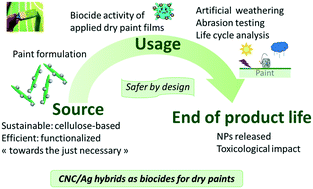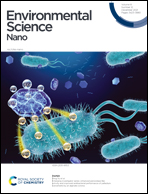CNC/AgNP hybrids as safer-by-design biocides in paints†
Abstract
In this work, biocidal paints are designed by a safer-by-design approach where an efficient antibacterial activity is provided by nanohybrids consisting of silver nanoparticles (AgNPs) nucleated on a bio-based substrate (cellulose nanocrystals, CNCs), to be included in an amount as low as possible and dispersed in an aqueous suspension. Three CNC/AgNP hybrids varying in CNC surface modifications are characterized in depth by transmission electron microscopy, atomic absorption spectroscopy and X-ray diffraction, and used in realistic paint formulations. The analysis of dry-film degradation followed by artificial weathering and mechanical solicitation (i.e., abrasion) reveals a reduced airborne emission of particles that could have harmful impact on human health and the environment. However life cycle assessment shows a weak beneficial impact due to the low amount compared to the paint manufacturing impact. Finally, the biocidal activity was clearly detected on dry paints using Bacillus Subtilis bacteria. It demonstrates that the resulting dry-state paints containing the AgNPs best dispersed and with the smallest size (i.e., 11 nm) show the strongest biocidal effect. This approach allows considerable reduction of the Ag amount to reach an antibacterial effect comparable to AgCl. Moreover, no specific toxicity is revealed and only biodegradable CNCs will persist in the environment at the end of the antimicrobial activity provided by AgNPs. The development of such CNC/AgNP hybrids, considering the overall life cycle of the material like paint, opens the road to the development of highly efficient and more eco-friendly materials.

- This article is part of the themed collection: Nanomaterials in air


 Please wait while we load your content...
Please wait while we load your content...